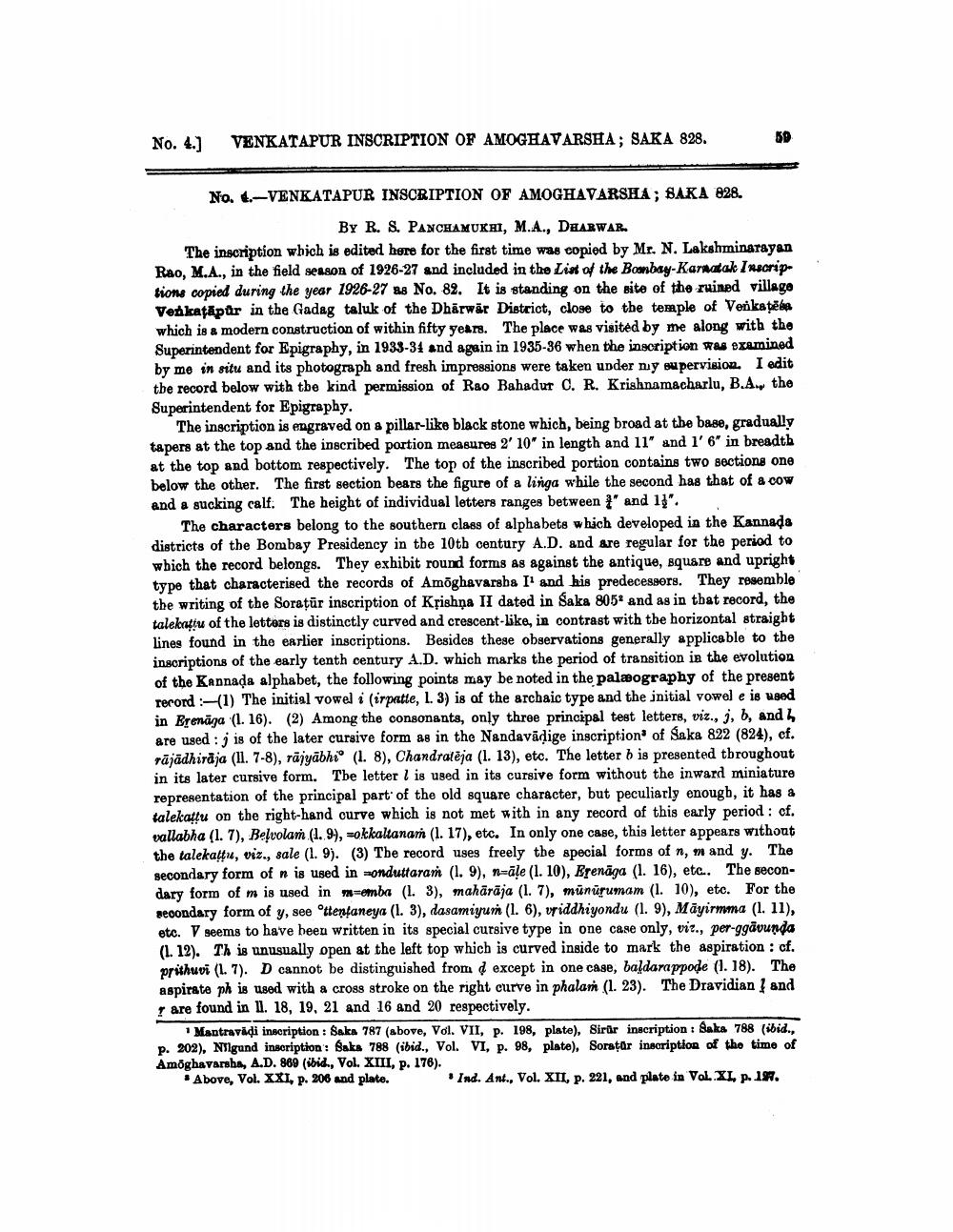________________
No. 4.)
VENKATAPUR INSCRIPTION OF AMOGHAVARSHA; SAKA 828.
OD
No. 4.-VENKATAPUR INSCRIPTION OF AMOGHAVARSHA; SAKA 828.
BY R. S. PANCHAMUKH, M.A., DHARWAR. The inscription which is edited here for the first time was copied by Mr. N. Lakshminarayan Rao, M.A., in the field season of 1926-27 and included in the List of the Bombay-Karnatak Inscriptions copied during the year 1926-27 as No. 82. It is standing on the site of the ruined village Venkatāpur in the Gadag taluk of the Dharwär District, close to the temple of Verkstēka which is a modern construction of within fifty years. The place was visited by me along with the Superintendent for Epigraphy, in 1933-34 and again in 1935-36 when the inscription was examined by me in situ and its photograph and fresh impressions were taken under ny supervision. I edit the record below with the kind permission of Rao Bahadur C. R. Krishnamacharlu, B.A. the Superintendent for Epigraphy.
The inscription is engraved on a pillar-like black stone which, being broad at the base, gradually tapers at the top and the inscribed portion measures 2' 10' in length and 11" and 1' 6' in breadth at the top and bottom respectively. The top of the inscribed portion contains two sections one below the other. The first section bears the figure of a linga while the second has that of a cow and a sucking calf. The height of individual letters ranges between t" and 13".
The characters belong to the southern class of alphabets which developed in the Kannada districts of the Bombay Presidency in the 10th century A.D. and are regular for the period to which the record belongs. They exhibit round forms as against the antique, square and upright type that characterised the records of Amõghavarsha Il and his predecessors. They resemble the writing of the Soraţür inscription of Krishna II dated in Saka 805and as in that record, the talekattu of the lettors is distinctly curved and crescent-like, in contrast with tbe horizontal straight lines found in the earlier inscriptions. Besides these observations generally applicable to the inscriptions of the early tenth century A.D. which marks the period of transition is the evolution of the Kannada alphabet, the following points may be noted in the palæography of the present record (1) The initial vowel i (irpatte, 1. 3) is f the archaic type and the initial vowel e is used in Brenāga (1. 16). (2) Among the consonants, only three principal test letters, viz., j, b, and are used : j is of the later cursive form as in the Nandavādige inscription of Saka 822 (824), cf. rājadhirdja (11. 7-8), rājyabhio (1.8), Chandralēja (1. 13), etc. The letter b is presented tbroughout in its later cursive form. The letter l is used in its cursive form without the inward miniature representation of the principal part of the old square character, but peculiarly enough, it has a talekattu on the right-hand curve which is not met with in any record of this early period: cf. vallabha (1. 7), Beļvolam (1.9), sokkaltanar (1. 17), etc. In only one case, this letter appears without the talekattu, viz., sale (1. 9). (3) The record uses freely the special forms of n, m and y. The secondary form of n is used in onduttarar (1.9), n-ale (1. 10), Erenāga (1. 16), etc.. The secondary form of m is used in emba (1. 3), mahārāja (1. 7), münürumam (1. 10), etc. For the secondary form of y, see ottenfaneya (1. 3), dasamiyur (1. 6), vriddhiyondu (1. 9), Māyirmma (1. 11), etc. V seems to have been written in its special cursive type in one case only, viz., per-ggāvunda (1. 12). Th is unusually open at the left top which is curved inside to mark the aspiration : cf. prithuvi (L. 7). D cannot be distinguished from d except in one case, baļdarappode (1. 18). The aspirate ph is used with a cross stroke on the right curve in phalan (1. 23). The Dravidian and are found in 11. 18, 19, 21 and 16 and 20 respectively.
Mantravadi inscription : Saka 787 (above, Vol. VII, p. 198, plate), Sirar inscription : Saka 788 (ibid., p. 202), Nilgund inscription : Baks 788 (ibid., Vol. VI, p. 98, plate), Sorstar inscription of the time of Amoghavarsha, A.D. 869 (ibid., Vol. XIII, p. 176). . Above, Vol. XXI, p. 206 and plate.
Ind. Ant., Vol. XII, p. 221, and plate in Vol. XI, p. 19.




